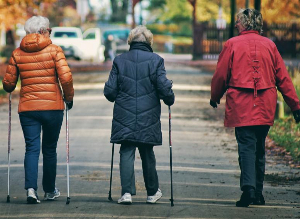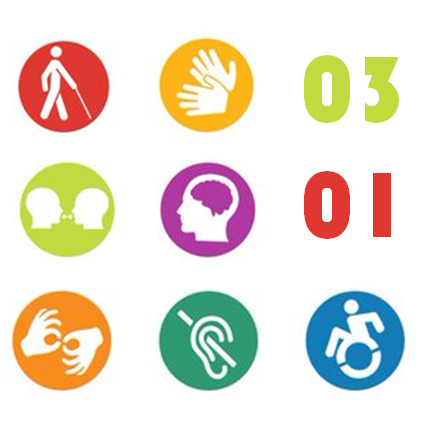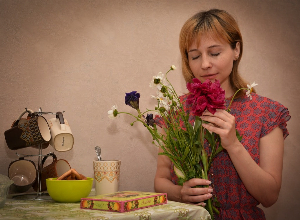What is disability? Are we an inclusive world?
Published Dec 3, 2020 • By Gilda Teissier
In 1992, the United Nations declared December 3rd as the International Day of Persons with Disabilities (IDPD), with the aim of raising awareness of the situation of persons with disabilities in every aspect of political, social, economic and cultural life.
Today, we join the awareness effort by highlighting the challenges that people with disabilities face on a daily basis, as well as the ways we can tear down the barriers of misunderstanding, indifference and exclusion.
What is disability? What is an inclusive society? What efforts are being made to foster inclusion?
We tell you all about it in our article!

According to the United Nations, the population of people with disabilities around the globe totals one billion people. In the United States, the figure is approximately 61 million, or nearly 1 in 4 (26%) of the population. Of this number, it’s estimated that one third are living with a mental or neurological condition and two-thirds of these people will not seek professional medical help, largely due to stigma, discrimination, and neglect. This is why this year the IDPD motto is ‘Not all Disabilities are Visible’.
What is disability?
Generally speaking, disability is any condition of the body or mind that makes it more difficult for a person to perform certain activities and interact with the world around them. There are different types of disability, including those that affect an individual's:
- Vision
- Movement
- Thinking
- Remembering
- Learning
- Communicating
- Hearing
- Mental health
- Social relationships

Image by Accessible Canada
Disability is considered by the World Health Organization in three dimensions: impairment of a person's body structure or function, or mental functioning; activity limitation, such as difficulty walking, seeing, hearing, or problem solving; and participation restrictions in daily activities like working, social and recreation events, or procuring health care or preventative services. These dimensions, combined with the variety of forms of disability, create an even bigger spectrum.
Disabilities have many origins and can be related to:
- an injury, such as a spinal cord injury
- a long standing condition, such as diabetes
- a progressive condition, such as muscular dystrophy
- a static condition, such as the loss of a limb
- an intermittent condition, such as multiple sclerosis
- certain developmental conditions that become apparent during childhood, like autism
- conditions present at birth (disorders in single genes, chromosomes, etc.) that may affect functions later in life such as cognition, mobility, vision, hearing, behavior and other areas.
A disability can be visible or invisible to the eye, can be permanent or temporary and can have minimal or significant impact on a person’s abilities.
What is an inclusive society?
Disability inclusion means including people with disabilities in everyday activities and encouraging them to have roles similar to those of their friends or associates who do not have a disability. The World Summit for Social Development (Copenhagen 1995) also states that an inclusive society is a “society for all in which every individual, having the same rights and responsibilities, has an active role to play.” It goes beyond simply encouraging people - it requires ensuring that adequate policies and systems are in place within communities and organizations so that everyone has the same opportunities to participate in all aspects of life to the fullest extent of their wishes and abilities.
In today's world, there are still many barriers that limit access to a complete, inclusive society. According to the WHO there are factors in a person’s environment that, through their absence or presence, limit functioning and create disadvantage. These factors include aspects such as:
- a lack of accessibility, for example in transport
- a lack of assistive technology (assistive, adaptive and rehabilitative devices)
- negative attitudes of people towards disability, such as stereotypes or stigmatization, which can have an impact on socialization or even getting a job
- services, systems and policies that are either non-existent or that hinder the involvement of all people with a health condition in all areas of life
- barriers to communication that include hearing, speaking, reading, writing, and/or comprehension
What efforts being made to achieve better inclusion?
In the US, there are three federal laws that assure inclusion and protect the rights of people with disabilities:
- Section 504 of the Rehabilitation Act of 1973
- The Americans with Disabilities Act (ADA) of 1990, which was followed by the ADA Amendments Act of 2008 in an attempt to restore the original intent of the legislation
- The Patient Protection and Affordable Care Act of 2010
Around the world, many things are developing and starting to change the game in terms of inclusion.
Here are a few examples:
- Universal design: its goal is to simplify life for everyone by making products, communication, and the physical environment more usable by as many people as possible, at little or no extra cost. Examples range from simple things like including an instruction manual with clear drawings and no text, or counters and service windows low enough for everyone to reach, to more elaborate things like power doors with sensors at entrances that are convenient for all users.
- Accessibility: this is when the needs of people with disabilities are taken into account in the way places and products are designed, built or fitted out. Examples include parking spaces closer to entrances, healthcare professionals using sign language or having access to a translator, etc.
- Reasonable accommodations: this refers to modifications made to items, procedures or systems that enable a person with a disability to use them to the greatest extent possible. Examples include books in Braille, large print or audio books for people who are blind or visually impaired.
- Assistive technology: is devices or equipment that can be used to help a person with a disability to fully engage in daily activities. Examples include can be anything from a wheelchair or a magnifying glass, to a computer that reads text out loud and helps a person communicate.
- Independent and/or assisted living: this is about enabling people with disabilities to express themselves, make choices and control their daily lives. It also includes having a person or a place for adults who need help with daily tasks.
Another change needed to achieve inclusion is education and a change in mentality. Currently, many associations and NGOs are trying to achieve these changes all over the world.
A concrete example is International Inspiration and Cheshire Foundation - Action for Inclusion who have been working together in Ethiopia on a project that uses sports to help children and young people with disabilities to participate fully in community life. The ‘Sport for Inclusive Development Project’ has been working closely with local communities, sport clubs, regional and local governments and thousands of children and young people to provide regular spaces for people with and without disabilities to come together through sports.
By coming together through sports, the program is achieving incredible results in terms of inclusion both on and off the sports field, with greater representation of people living with disabilities in local decision making processes, a tangible change in attitudes towards disability and a growing number of local role models for children and young people with disabilities.
Conclusion
Disability comes in all shapes and sizes, it can be visible or not, which is why it is so important that we all have an inclusive attitude towards everyone and demand equal access and opportunities for all.
Let us remember that social inclusion does not mean a uniformity of people, but a society that leaves room for diversity and continues to foster engagement.
Do you think our society is inclusive enough?
Share your thoughts and questions in the comments below!
Take care!
Sources:
- Building Back Better: Toward a Disability-Inclusive, Accessible and Sustainable Post-COVID-19 World, United Nations
- Disability and Health Overview, Center for Disease Control and Prevention
- International Classification of Functioning, Disability and Health, World Health Organization
- The moment I caught a glimpse of what an inclusive world might look like. International Inspiration"
- World Health Organization, International Classification of Functioning, Disability and Health. Geneva: 2001, WHO. p. 214
Comments
You will also like

What are the dangers associated with the over-the-counter sale of certain medicines?
Dec 19, 2020 • 6 comments

 Facebook
Facebook Twitter
Twitter

